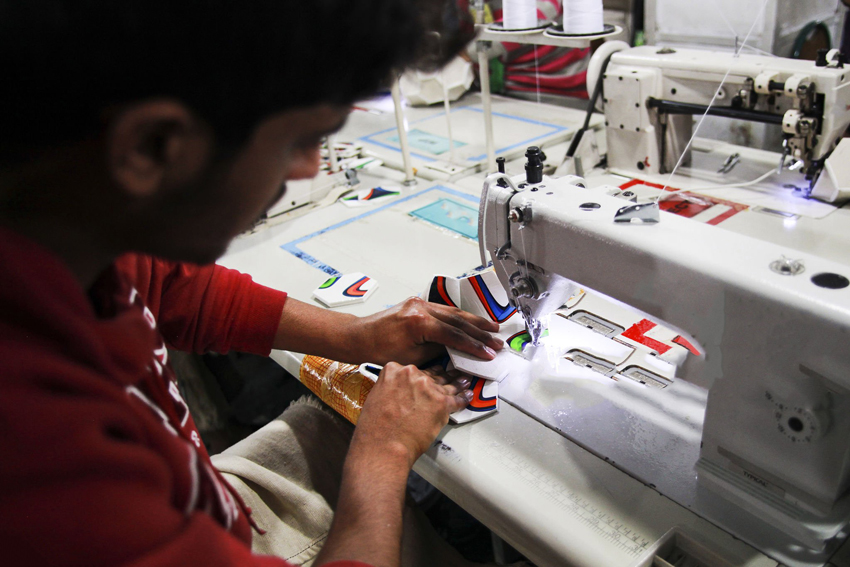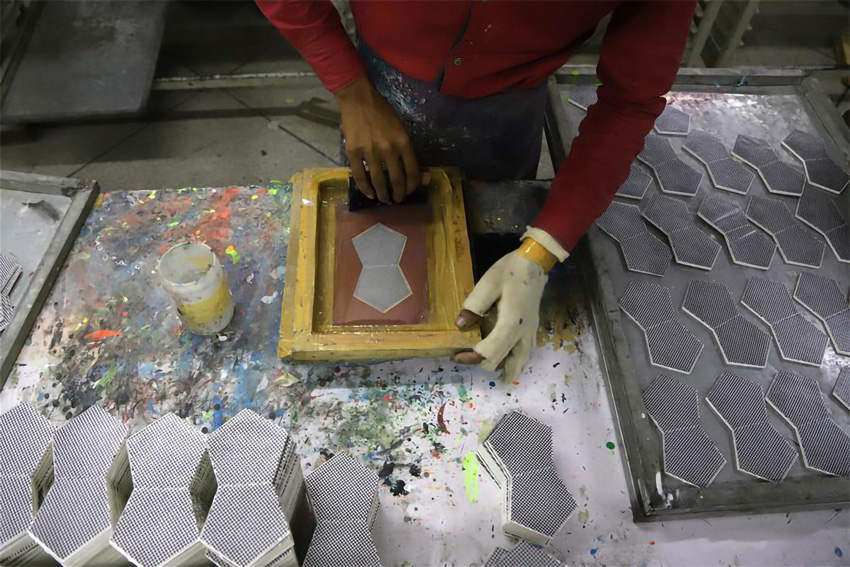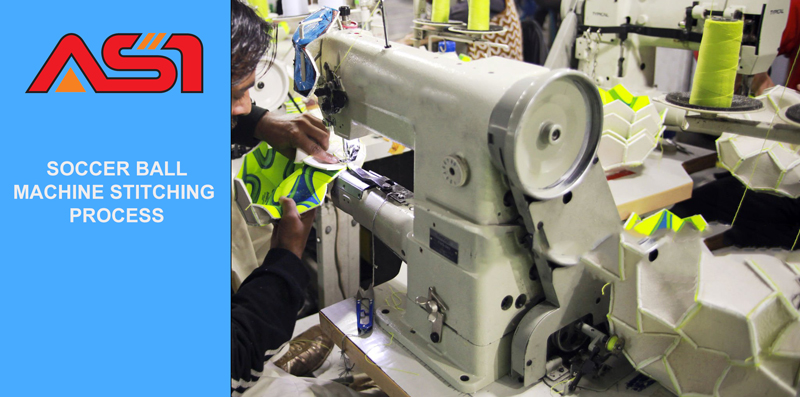The Art and Science Behind Machine-Stitched Soccer Ball Manufacturing

Table of Contents
ToggleSoccer, the world’s most popular sport, is synonymous with the iconic black-and-white ball that graces the pitch. Have you ever wondered how these soccer balls come to life? Beyond the thrilling matches and spectacular goals lies a fascinating process of crafting the perfect soccer ball. In this comprehensive guide, we will delve into the intricate journey of creating machine-stitched soccer balls – from raw materials to the final product that millions of players around the world kick, pass, and score with.
What is a machine-stitched soccer ball?
A machine-stitched soccer ball is a type of soccer ball constructed by sewing the panels together using specialized sewing machines. These machines ensure uniform and precise stitching, resulting in a consistent and reliable product.
How is a machine-stitched soccer ball different from a hand-stitched soccer ball?
Hand-stitched soccer balls are crafted manually by skilled artisans, while machine-stitched soccer balls are manufactured using automated sewing machines. Hand-stitched balls often exhibit unique craftsmanship and may have irregularities, whereas machine-stitched balls are more standardized in terms of stitching.
What are the benefits of machine-stitched soccer balls?
Consistency: Machine-stitching ensures uniformity in the ball’s construction.
Durability: Machine-stitched balls are typically more durable due to precise stitching.
Affordability: They are often more budget-friendly than their hand-stitched counterparts.
Availability: Machine-stitched balls are readily available in various designs and sizes.
What are the drawbacks of machine-stitched soccer balls?
Less Artistic: Machine-stitched balls lack the artistic touch and character of hand-stitched ones.
Less Control: Craftsmanship and customization options are limited in machine stitching.
I. The Foundation: Raw Materials
Before the first stitches are made, the foundation is laid with meticulously chosen raw materials. These materials serve as the building blocks for the soccer ball’s durability, bounce, and overall performance. Let’s delve deeper into the primary components that constitute this foundational stage:
1. The Materials Used in Machine-Stitched Soccer Balls
What materials are used to make a machine-stitched soccer ball?
Machine-stitched soccer balls are made from a combination of materials:
Outer Cover: Typically, a durable synthetic material like PU (Polyurethane) or PVC (Polyvinyl Chloride).
Inner Bladder: Made of latex or butyl, the bladder provides shape and bounce to the ball.
Threads: High-quality threads, often polyester or nylon, are used for stitching.
How are these materials chosen?
The choice of materials depends on factors such as cost, performance, and intended use. PU is preferred for premium balls, while PVC may be used for practice balls. Bladder material affects the ball’s responsiveness, with latex offering a better feel but requiring more maintenance.

Durability and Resistance: Synthetic leather is engineered to withstand the abrasions, impacts, and environmental factors that a soccer ball is exposed to during intense matches. This durability ensures that the ball retains its shape and quality over extended periods of play.
Consistency: Unlike natural leather, synthetic leather maintains a consistent texture and properties throughout production batches. This consistency contributes to the uniformity of the final product, ensuring that players experience the same quality regardless of the ball they choose.
2. Bladders: Inner Tubes of Resilience
Bladders, the inner tubes of the soccer ball, play a pivotal role in determining the ball’s bounce, shape, and overall resilience. Crafted from rubber or synthetic materials, bladders are carefully designed to withstand the pressure exerted during play.
Bounce and Resilience: Bladders provide the soccer ball with its characteristic bounce. The materials used are chosen for their elasticity, allowing the ball to rebound predictably and maintain consistent performance throughout a match.
Shape Retention: Bladders are engineered to maintain the ball’s shape, ensuring that it retains its roundness and stability even after repeated use. This quality is crucial for accurate passing, shooting, and control during games.
Pressure Management: The materials used in bladders are selected to effectively manage air pressure. This ensures that the ball remains inflated to the desired level, contributing to its playability and performance on the field.
II. Precision Cutting: Creating the Panels
Once the raw materials are selected, the journey of crafting a machine-stitched soccer ball continues with the precision cutting of synthetic leather into distinct hexagonal or pentagonal panels. This step is not only critical for the ball’s visual aesthetics but also for its overall shape, feel, and performance on the field. Let’s explore this pivotal phase in greater detail:
1. Aesthetic and Functional Significance
The panels of a soccer ball are not only functional components but also contribute to its iconic appearance. The number and arrangement of these panels play a significant role in determining the ball’s shape, aerodynamics, and overall feel during play. The design of the panels contributes to the ball’s stability in flight and its behavior upon impact with players’ feet.
2. Customization Based on Ball Type and Size
The number of panels on a soccer ball can vary based on its size and intended use. While the most common configuration is the 32-panel design, different variations exist, such as 18, 26, or 42-panel designs. The size of the ball, whether it’s a standard size 5 ball or a smaller size for youth players, also influences the specifics of the cutting process.
3. Precision Cutting Techniques
The cutting of synthetic leather panels requires a high level of precision. Cutting machines equipped with advanced technology ensure that each panel is cut to exact dimensions and angles. This precision guarantees uniformity in panel size, which is essential for maintaining the ball’s overall shape and ensuring a balanced bounce.

4. Shape and Pattern Considerations
The arrangement of the panels contributes to the ball’s overall shape. The classic 32-panel design creates a spherical shape that facilitates consistent flight and bounce. Manufacturers may experiment with different arrangements to achieve specific aerodynamic properties or unique visual patterns.
5. Quality Control and Consistency in Soccer Ball Manufacturing
During the cutting process, quality control measures are implemented to ensure that every panel meets the established standards. Consistency in panel size and shape is crucial for producing soccer balls that perform predictably and provide a satisfying experience for players.
6. Craftsmanship and Technology Integration in Soccer Ball Manufacturing
Precision cutting combines craftsmanship and technological innovation. Modern cutting machines are equipped with computerized systems that guide the cutting process, resulting in accuracy down to the millimeter. This integration of skill and technology ensures that each panel is cut with precision and care.
III. Adding the Graphics
After panels cutting, combines artistry and identity—the addition of branding and finishing touches. While many aspects of the soccer ball manufacturing process are automated, this phase often involves manual intervention to imbue each panel with a unique identity and visual appeal. Let’s delve into this phase, where the ball becomes more than just a sports equipment—it becomes a canvas for expression and recognition.
1. Personalized Identity
Branding goes beyond mere decoration; it’s about personalizing each ball and giving it a distinct identity. Manufacturers use this stage to showcase their logo, company name, or other design elements that set their products apart. This identity not only represents the manufacturer but also becomes a part of the player’s connection to the game.
2. Manual Artistry
While many aspects of soccer ball manufacturing are mechanized, the addition of branding often involves manual artistry. Skilled artisans apply paints or decals with precision, ensuring that every ball reflects the intended design. This manual touch adds a human element that contributes to the uniqueness of each ball.

3. Visual Aesthetics
The aesthetic appeal of a soccer ball is enhanced during this stage. Colors, patterns, and designs can be tailored to align with the intended target audience or to create a specific visual impact. The choice of branding elements can evoke emotions and associations, making the ball visually captivating and memorable.
4. Automated Branding
In some cases, manufacturers opt for automated branding processes. Advanced machines can apply logos, designs, or patterns with precision and consistency. Automated branding guarantees uniformity across a production batch, maintaining a high level of visual quality.
5. Marketing and Recognition
Branding is not just about aesthetics; it’s a tool for marketing and recognition. When players and spectators see a distinct logo or design on a soccer ball, they instantly recognize the brand behind it. This association fosters loyalty and trust among consumers.
6. Craftsmanship and Uniqueness
The printing stage encapsulates the craftsmanship and uniqueness that define soccer ball manufacturing. The combination of automated precision and manual artistry ensures that every ball is a work of art—an embodiment of technology and human touch that’s ready to be introduced to the world of soccer.
IV. Holes for Stitching: The Power of Precision
As the journey of crafting a machine-stitched soccer ball continues, we delve into the stage where punching machines take center stage. Meticulously punched holes in the panels lay the foundation for the intricate stitching process that follows. This critical step involves a careful orchestration of precision, ensuring that the panels seamlessly come together. Let’s explore the nuances of this phase in greater detail:
1. Purpose of Punched Holes
Punched holes in the panels serve as entry points for stitching. These holes play a vital role in guiding the stitching needles and securing the panels together. The precision of the hole placement is essential for maintaining the ball’s shape, ensuring consistent bounce, and contributing to its overall durability.
2. Tailored Placement and Design
The placement and design of the punched holes are not arbitrary; they are tailored to the specific design of each ball. The use of panels and the intended stitching pattern influence the number and location of these holes. Manufacturers consider factors such as symmetry, balance, and ease of stitching when determining hole placement.
3. Consistency and Accuracy
The use of punching machines ensures consistency and accuracy in hole placement across all panels. This uniformity is essential for achieving a well-balanced ball that performs predictably on the field. The precision of the holes directly impacts the alignment of the panels during stitching, resulting in a seamless assembly.
4. Automated Precision
Modern punching machines are equipped with advanced automation technology that enhances the precision of hole placement. Computer-controlled systems guide the punching process, minimizing the risk of human error and ensuring that each hole is positioned with meticulous accuracy.
5. Ensuring Structural Integrity
The holes are strategically spaced to distribute the stress and tension created during the stitching process. This distribution of forces contributes to the ball’s structural integrity, preventing undue strain on individual panels and ensuring a longer lifespan for the final product.
6. Collaboration with Stitching Process
The punched holes and the subsequent stitching process are closely intertwined. The precision of the holes directly affects the efficiency and quality of stitching. When the panels are sewn together, the stitching needles glide through these holes smoothly, creating strong and durable seams that withstand the rigors of gameplay.
V. Seam Strength: Stitching the Panels Together
As the punched holes pave the way, the panels of a machine-stitched soccer ball unite in a symphony of precision and strength. This stage is where stitching machines take center stage, weaving threads through the meticulously placed holes to create a durable and cohesive whole. Let’s unravel the intricacies of this process and delve into the significance of a double stitch for heightened strength and endurance:
1. Precision Stitching Machines
Stitching machines, equipped with advanced technology, guide the panels through the stitching process. These machines are programmed to create consistent and accurate stitches, ensuring that every seam is both visually appealing and structurally sound.
2. Ensuring Seam Integrity
The stitching process is not solely about aesthetics; it’s about reinforcing the structural integrity of the ball. Each stitch provides a connection point between the panels, creating a seamless bond that prevents distortion and maintains the ball’s spherical shape. Seam integrity directly impacts how the ball behaves during kicks, passes, and dribbles.
3. Influence on Ball Performance
The quality of stitching directly influences the ball’s performance on the field. Properly stitched panels contribute to consistent flight characteristics, predictable bounce, and accurate ball control. Stitching irregularities, on the other hand, can lead to imbalanced flight paths and unpredictable bounces.
4. Art of Even Tension
Achieving even tension during the stitching process is a critical aspect of producing a top-notch soccer ball. Consistent tension ensures that the panels are securely joined without warping or distorting their shape. This level of attention to detail ensures a uniform surface for players to interact with.
5. Craftsmanship and Longevity
The stitching process combines craftsmanship and technology, as skilled operators oversee the machines’ operation. Their expertise ensures that every ball is meticulously stitched, aligning with quality standards that contribute to the ball’s longevity and performance over time.

VI. Inner Resilience: Inserting the Bladders
As the panels come together, the inner essence of a soccer ball takes center stage. Bladders, the inflatable inner tubes responsible for the ball’s bounce and shape retention, are integrated into the ball using sophisticated automated machines. This step is pivotal in ensuring uniformity in both bladder placement and inflation, thereby contributing to the ball’s overall performance and durability.
1. The Role of Bladders
Bladders are not just components; they are the heart of the ball’s resilience. Composed of rubber or synthetic materials, bladders provide the essential air pressure that determines the ball’s bounce and feel. Their inflation level directly affects the ball’s playability and response to different types of impact.
2. Automated Precision
Automated machines are employed to insert bladders with precision. These machines are equipped with advanced technology that guarantees consistent placement of bladders within the ball’s structure. This automation eliminates human variability and ensures that each ball meets the exact specifications for bladder positioning.
3. Uniformity in Inflation
The automated insertion process extends to bladder inflation as well. The machines control the amount of air injected into each bladder, guaranteeing uniform inflation levels across all balls. This uniformity contributes to a standardized level of bounce and responsiveness for players of all skill levels.
4. Shape Retention and Consistency
Bladders play a vital role in maintaining the ball’s shape over time. The even pressure exerted by the inflated bladders ensures that the ball retains its spherical form, which is crucial for predictable flight and accurate play during matches.
5. Impact on Bounce and Playability
The air pressure within the bladders determines the ball’s bounce characteristics. An appropriately inflated bladder leads to consistent and reliable bounces, allowing players to anticipate the ball’s behavior and make calculated moves on the field.
6. Quality Assurance
Automated bladder insertion is not just about efficiency; it’s also a means of quality assurance. The machines are calibrated to meet specific standards for inflation and positioning, leaving no room for discrepancies. This meticulous approach ensures that every ball leaving the production line meets the high-quality benchmarks set by manufacturers.
VII. Rigorous Testing: Ensuring Quality and Performance
As the various components of a machine-stitched soccer ball come together, the importance of quality and performance cannot be overstated. This is where rigorous testing procedures step in, using automated equipment to meticulously assess critical attributes such as roundness and bounce. The adherence to stringent quality and performance standards is not just a matter of satisfying players’ expectations—it’s about prioritizing their safety and enjoyment on the field.
1. Automated Precision Testing
Automated testing equipment plays a vital role in evaluating the quality of each ball. These cutting-edge systems use advanced sensors and technology to measure specific parameters that directly impact a ball’s performance. The data collected provides an objective assessment, free from human bias.
2. Roundness and Symmetry
One of the fundamental tests conducted is assessing the roundness and symmetry of the ball. Automated equipment precisely measures the diameter of the ball from various angles to ensure that it meets defined standards. A perfectly round ball ensures consistent flight characteristics and bounce.
3. Bounce Testing
The bounce of a soccer ball is a defining attribute that influences gameplay. Automated testing equipment releases the ball from a specific height and accurately measures the height of its bounce. This measurement verifies that the ball’s bounce adheres to predetermined standards, allowing players to anticipate and respond to the ball’s behavior during matches.
4. Uniformity in Performance
Consistency is a cornerstone of soccer ball manufacturing. Automated testing ensures that each ball performs uniformly across a range of attributes, creating a level playing field for players. Whether on a professional pitch or a local field, the performance of the ball remains predictable and reliable.
5. Meeting Safety Standards
Beyond performance, testing also ensures the safety of players. Balls that deviate from quality standards can behave unpredictably, posing risks to players’ well-being. By adhering to strict testing protocols, manufacturers prioritize the safety of those who use their products.
6. Continuous Improvement
Automated testing not only confirms adherence to standards but also provides valuable data for continuous improvement. By analyzing test results, manufacturers can identify areas for enhancement and innovation, contributing to the evolution of soccer ball design and manufacturing techniques.
VIII. Secure Packaging: Protecting the Craftsmanship
With the soccer ball now a complete work of art and engineering, the journey doesn’t end at the factory gates. The final steps involve securing the product through thoughtful packaging, ensuring that the craftsmanship and precision invested in its creation remain intact during transportation and storage. Let’s delve into this phase, where protective packaging becomes a shield for preserving the ball’s quality and appearance.
1. Purpose of Packaging
Packaging goes beyond aesthetics; it’s about safeguarding the soccer balls from potential damage during transit. The packaging materials are carefully selected to provide cushioning, support, and structural integrity, ensuring that the balls reach players in pristine condition.
2. Protection Against Impact
Transportation can subject packages to various levels of impact and jostling. Secure packaging acts as a buffer against these forces, preventing the soccer balls from being crushed, deformed, or scratched. This protection ensures that the balls maintain their shape, symmetry, and visual appeal until they reach their final destination.
3. Materials Selection
Packaging materials such as cardboard boxes or bags are chosen for their ability to withstand external pressures. These materials are sturdy and durable, offering a layer of defense against potential hazards encountered during transit.
4. Tailored Packaging Design
The design of the packaging is tailored to the shape and size of the soccer balls. This ensures a snug fit that minimizes movement within the package, reducing the risk of impact-related damage. Customized packaging solutions further enhance the protection provided to each ball.
5. Prevention of Moisture and Dust
Packaging materials also act as a barrier against environmental elements such as moisture and dust. This protection prevents potential damage to the ball’s surface and materials, ensuring that the ball remains in optimal condition until it’s ready to be used.
6. Extending Brand Experience
Packaging is an extension of the brand experience. Logos, graphics, and labeling on the packaging reinforce the brand’s identity and association with the soccer ball. This connection continues even after the product has left the manufacturing facility.
IX. Global Distribution: From Factory to Field
As the final chapter of the soccer ball manufacturing journey unfolds, the spotlight shifts from the factory floor to the global stage. With branding, quality assurance, and packaging complete, the balls are now ready to begin their journeys across the world. The culmination of precision, artistry, and innovation takes center stage as the balls make their way from the factory to the eager hands of players, coaches, and enthusiasts on fields far and wide.
1. A Global Network
Soccer ball manufacturers operate within a vast network that spans continents and cultures. The global distribution process is a well-choreographed dance involving logistics, transportation, and coordination to ensure that the balls reach their intended destinations efficiently.
2. Transportation Modes
The journey from factory to field involves various transportation modes, including trucks, ships, and airplanes. These modes are chosen based on factors such as distance, urgency, and volume. Efficient transportation ensures that the balls arrive at their destinations in a timely manner.
3. Retailers and Distributors
Retailers and distributors play a vital role in the distribution process. They act as intermediaries, connecting the manufacturing hubs with the end users—players and enthusiasts. These partners ensure that the balls are available in stores, online platforms, and sporting events, making them accessible to a diverse audience.
4. Tailored to Demand
Distribution strategies are often tailored to meet the demands of different regions and markets. Factors such as local preferences, seasonal variations, and tournament schedules influence the timing and volume of distribution. Manufacturers work closely with partners to ensure that supply aligns with demand.
5. The Global Game Unites
Soccer is a universal language that transcends borders. The distribution of soccer balls not only supplies players with essential equipment but also fosters a sense of unity among players worldwide. Each ball carries with it the legacy of the manufacturing process, connecting players through shared experiences on the field.
6. Enabling Dreams
As the balls reach players of all ages and skill levels, they enable dreams to take flight. Young players learning the basics, seasoned athletes competing at professional levels, and enthusiasts playing for the sheer joy of the game—all rely on the quality and performance of these balls to enhance their experiences and achievements.
Conclusion
The manufacturing of machine-stitched soccer balls is a harmonious blend of technology, precision, and artistry. From the selection of materials to the final packaging, each step contributes to the creation of a high-quality, consistent product that graces soccer fields worldwide. This intricate process ensures that players of all ages and skill levels can experience the joy of the game with a reliable and well-crafted companion. So, the next time you spot a soccer ball soaring through the air, remember the intricate journey it took from raw materials to the beautiful game we all cherish.
- Facebook
- Twitter
- Linkedin
- Whatsapp





